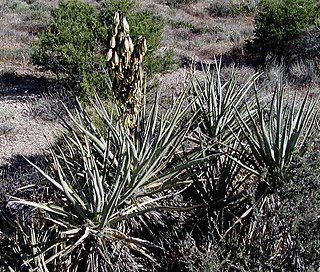
Yucca baccata is a common species of yucca native to the deserts of the southwestern United States and northwestern Mexico, from southeastern California north to Utah, east to western Texas and south to Sonora and Chihuahua. It is also reported in the wild in Colombia.
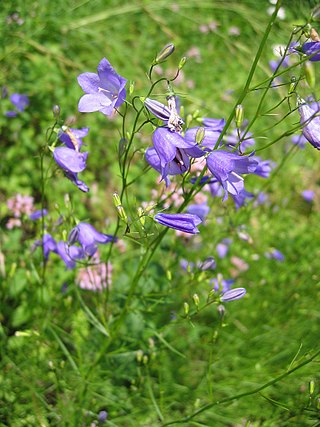
Campanula rotundifolia, the common harebell, Scottish bluebell, or bluebell of Scotland, is a species of flowering plant in the bellflower family Campanulaceae. This herbaceous perennial is found throughout the temperate regions of the northern hemisphere. In Scotland, it is often known simply as bluebell. It is the floral emblem of Sweden where it is known as small bluebell. It produces its violet-blue, bell-shaped flowers in late summer and autumn.

Hesperocyparis arizonica, the Arizona cypress, is a North American species of tree in the cypress family Cupressaceae, native to the southwestern United States and Mexico. Populations may be scattered rather than in large, dense stands.
Black orchid or Black Orchid may refer to:
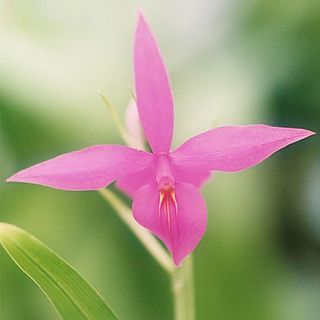
Barkeria, abbreviated Bark in horticultural trade, is a genus of orchids. It consists of about 17 currently recognized species native to Mexico and Central America. This genus was once considered part of Epidendrum. Type species is Barkeria elegans; this is now considered a synonym of B. uniflora yet retains its status as type per ICN.

Dactylorhiza majalis, or the broad-leaved marsh orchid, is a terrestrial Eurasian orchid.

Dactylorhiza viridis, the frog orchid, is a species of flowering plant in the orchid family Orchidaceae. It has also been treated as the only species Coeloglossum viride of the monotypic genus Coeloglossum.

Opuntia engelmannii is a prickly pear common across the south-central and Southwestern United States and northern Mexico. It goes by a variety of common names, including desert prickly pear, discus prickly pear, Engelmann's prickly pear in the US, and nopal, abrojo, joconostle, and vela de coyote in Mexico.

Anemone hepatica, the common hepatica, liverwort, liverleaf, kidneywort, or pennywort, is a species of flowering plant in the buttercup family Ranunculaceae, native to woodland in temperate regions of the Northern Hemisphere. This herbaceous perennial grows from a rhizome.
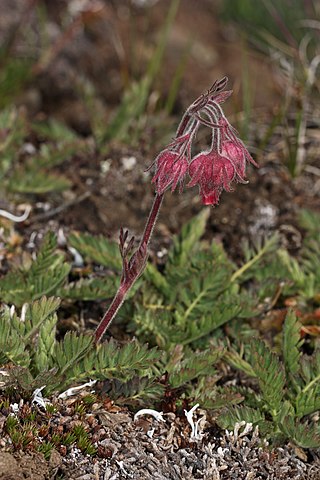
Geum triflorum, commonly known as prairie smoke, old man's whiskers, or three-flowered avens, is a spring-blooming perennial herbaceous plant of the Rosaceae family. It is a hemiboreal continental climate species that is widespread in colder and drier environments of western North America, although it does occur in isolated populations as far east as New York and Ontario. It is particularly known for the long feathery plumes on the seed heads that have inspired many of the regional common names and aid in wind dispersal of its seeds.

Pinus pseudostrobus, known in English as the smooth-bark Mexican pine and in Spanish as chamite or pacingo, is a tree found in forests of Mexico and Central America. It is 8 to 25 m tall with a dense and round top.It is threatened by logging and wood harvesting. The bark is brown and fissured and smooth when young. It is subject to ex situ conservation. It grows at altitudes between 850 and 3250 m. from 26° to 15° north latitude, from Sinaloa, Mexico to Nicaragua and Honduras. It occurs within a rainfall regime that rains mostly in summer.

Dactylorhiza purpurella, the northern marsh orchid, is an orchid native to Great Britain, Ireland, the Netherlands, Denmark and Norway.

Castilleja exserta is a species of plant in the genus Castilleja which includes the Indian paintbrushes. Its common names include purple owl's clover, escobita, and exserted Indian paintbrush.

Trillium pusillum is a species of flowering plant in the family Melanthiaceae known by the common names dwarf trillium, least trillium and dwarf wakerobin. It is native to the southeastern and south-central United States from Oklahoma to Maryland.

Clowesia is a genus of the family Orchidaceae. Species of this genus are epiphytic and contain many pseudobulbs with several internodes. The leaves of this plant are arranged alternatively in two vertical rows on opposite sides of the rachis. Clowesia has a simple gullet flower that allows for pollination by male euglossine bees. The flowers are often unisexual and contain a viscidium.

Cycnoches ventricosum is a species of orchid native to southern Mexico, Belize and Central America.

Ferocactus fordii is a species of succulent plant in the family Cactaceae, commonly known as Ford's barrel cactus, endemic to the Baja California Peninsula of Mexico. It is spherical, growing to 50 cm (20 in) in diameter, with whitish-grey radial spines and solitary flowers of a deep rose pink, 4 cm (2 in) in diameter.
Dactylorhiza francis-drucei is a species of terrestrial orchid native to Great Britain and Ireland.
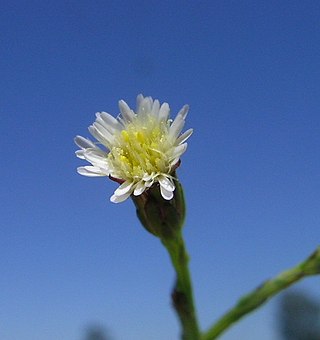
Symphyotrichum subulatum, commonly known as eastern annual saltmarsh aster or, in Britain and Ireland where it is naturalized, annual saltmarsh aster, is an annual plant in the family Asteraceae native to the eastern United States and the Gulf Coast to Texas. The species grows primarily in coastal salt marshes, although in the Ozarks it occurs as a non-marine weedy variety.

Senna hirsuta, commonly known as woolly senna, is a species of flowering plant in the family Fabaceae and is native to Central and South America, but is naturalised in many other countries. It is an erect or spreading shrub or herbaceous perennial with pinnate leaves, with two to six pairs of egg-shaped leaflets, and yellow flowers arranged in groups of two to six, with six fertile stamens and four staminodes in each flower.


















